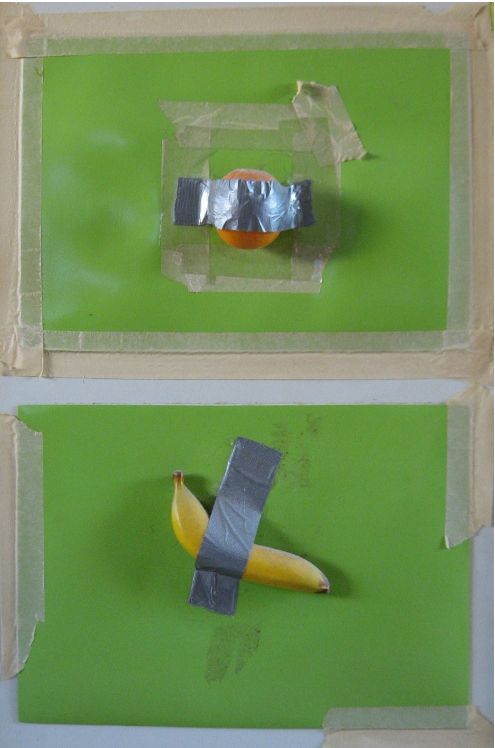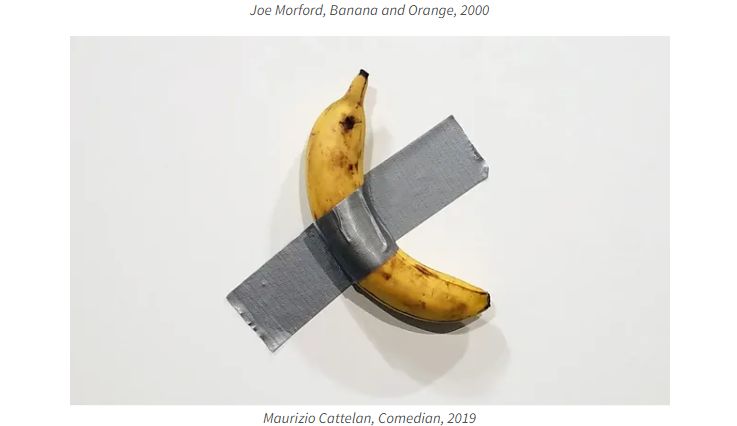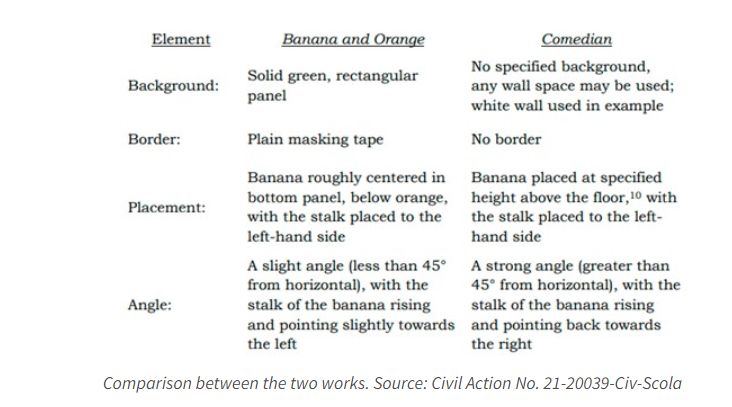Comedian, the famous work by Maurizio Cattelan, also known as "the banana", continues to hit the news. In fact, that banana glued to the wall with duct-tape that had caused such a fuss during the fair at Art Basel Miami Beach in 2019 (later bought by the Guggenheim for 150,000 dollars) has become the subject of a lawsuit against the Italian artist.
Joe Morford, from Glendale, California, said that Comedian is just a copy of his own duct-taped fruit, Banana & Orange, which he made 20 years earlier.
On his Facebook page Morford wrote: "I did this in 2000. But some dude steals my junk and pimps it for 120K+ in 2019. Plagiarism.?"
In fact, at a first sight the two works look quite similar.
Banana and Orange depicts a plastic yellow banana centered on a solid green rectangular panel and taped with gray duct-tape. Above the banana, on another green panel, is taped an orange.


Comedian is a real banana taped directly on the wall, with the same gray duct-tape.
The judge in 2022 declared that "No one can claim a copyright in ideas, so Morford cannot claim a copyright in the idea of affixing a banana to a vertical plane using duct tape. Nor can Morford claim a copyright in bananas or duct tape."
But he concluded: "While using silver duct tape to affix a banana to a wall may not espouse the highest degree of creativity, its absurd and farcical nature meets the 'minimal degree of creativity' needed to qualify as original."
Furthermore, "there are only so many choices an artist can make in colours, positioning and angling when expressing the idea of a banana taped to a wall. [.] In both works, a single piece of silver duct tape runs upward from left to right at an angle, affixing a centered yellow banana, angled downward left to right, against a wall. In both works, the banana and the duct tape intersect at roughly the midpoints of each, although the duct tape is less centered on the banana in Morford's work than in Comedian."
Now, the point seems to be the influence of Morford's work on the Italian artist: Had Cattelan had the possibility to see Banana and Orange, and consequently copy it?
To prove this point, Morford submitted a series of elements.
According to Morford, he originally developed Banana and Orange in California in 2001, and the work has been available on the internet through several websites for a number of years. Banana and Orange was first made available on YouTube in 2008, then it has also been shared on Facebook and Blogspot.
Additionally, his website analytics purportedly demonstrated that, between these three sites, Banana and Orange has been viewed by internet users in twenty-five different countries.
Finally, Morford registered a copyright for Banana and Orange in 2020: he originally submitted his application on January 25, 2020, and after an initial denial and resubmission, the United States Copyright Office approved his application on November 19, 2020.
The judge, though, found that this evidence was not enough to prove that Cattelan's work is not an independent creation. (see here, p. 7)
But in reality, while one banana duct-taped to a wall may look much like another, mere similarity is not enough to prove copyright infringement.
As the court noted, for a claim of infringement, Morford would be required to show that there was factual copying by Cattelan of Banana and Orange, and the similarities between the two works "extend to the work's original, protectible elements." It is the latter of these requirements that proves to be interesting and informative in this case.
When it comes to a banana taped to a wall, what exactly does copyright protect?
As stated in the judjment:
"To understand whether material is protected and therefore determine whether two works are substantially similar in a legally protectible manner, the Eleventh Circuit has prescribed the use of the "abstraction-filtration-comparison" test. Id. "In order to ascertain substantial similarity under this approach, a court first breaks down the allegedly infringed program into its constituent structural parts- that's abstraction." Id. (cleaned up.) "Next, the court sifts out all non-protectible material-filtration." Id. (cleaned up.) Finally, the "last step is to compare any remaining kernels of creative expression with the allegedly infringing [work] to determine if there is in fact a substantial similarity- comparison." Id. (cleaned up.)
Applying the abstraction-filtration-comparison test, the Court finds that Cattelan has established that Comedian is not substantially similar to Banana and Orange.
Primarily, this is determined at the filtration and comparison stages: once the Court sorts out what parts of Banana and Orange are protectible and compares those parts to Comedian, it becomes clear that there is no dispute of material fact that Comedian is too dissimilar to Banana and Orange to be a legal copy."

For all these reasons, the federal judge in Miami ruled in favor of the Italian artist.
One might doubt whether the two works are really dissimilar. But, apart from those underlined by the judge, there is another main difference, in our opinion: with Cattelan's Banana you can really say that you taste the concept of the art.
The article was originally published on HFG Law& Intellectual Property website: https://www.hfgip.com/news/cattelan-peels-accusation-his-banana-not-copy
The content of this article is intended to provide a general guide to the subject matter. Specialist advice should be sought about your specific circumstances.


